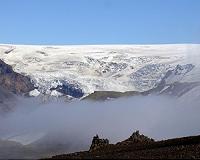 |
Newcastle, UK (SPX) Sep 23, 2010 Radio transmitters that can withstand temperatures of up to 900 oC could soon be dropped into the depths of the earth to provide early warning of a volcanic eruption. The state-of-the-art technology being pioneered by experts at Newcastle University uses Silicon Carbide electronics that can withstand temperatures equal to the inside of a jet engine. Measuring subtle changes in the levels of key volcanic gases such as carbon dioxide and sulphur dioxide, the wireless sensor would feed back real-time data to the surface, providing vital information about volcanic activity and any impending eruption. And because of its unique molecular structure - which is more stable than silicon - Silicon Carbide also has a high radiation tolerance opening up possibilities for its use in the nuclear industry. The team has developed the necessary components and are now working to integrate them into a device about the size of an iPhone that could be used in a variety of locations such as power plants, aircraft engines and even volcanoes. The device is one of a number of technologies which has been developed by experts at the university's Centre for Extreme Environment Technology, which was set up to 'go where no technology has gone before' and unlock the secrets of some of the world's harshest environments. Building reliable components that will continue to work under these conditions has been an on-going challenge for electronic engineers and the team at Newcastle University is recognised as a world leader in the field. Dr Alton Horsfall, who leads the Silicon Carbide work alongside Professor Nick Wright, explains: "At the moment we have no way of accurately monitoring the situation inside a volcano and in fact most data collection actually goes on post-eruption. With an estimated 500 million people living in the shadow of a volcano this is clearly not ideal. "We still have some way to go but using silicon carbide technology we hope to develop a wireless communication system that could accurately collect and transmit chemical data from the very depths of a volcano." And the device has other uses. "If someone sets off a bomb on the underground, for example, this will still sit on the wall and tell you what's going on," says Dr Horsfall. Volcanic monitoring is just one of the strands of research being carried out at the Centre for Extreme Environment Technology. With expertise in underwater communications, Professor Bayan Sharif, Jeff Neasham and Dr Charalampos Tsimenidis have developed a micro Remotely-Operated Vehicle that can be used to feed back environmental data about our coastlines. The team is also working on through metal communications which involves transmitting a signal through almost 10cm of steel and wireless sensor networks. Professor Nick Wright, pro-vice chancellor for innovation and research at Newcastle University, added: "The situations we are planning to use our technology in means it's not enough for the electronics to simply withstand extremes of temperature, pressure or radiation - they have to continue operating absolutely accurately and reliably. "Increasingly mankind is spreading out into harsher and more extreme environments as our population grows and we explore new areas for possible sources of energy and food in order to sustain it. "But with this comes new challenges and this is why research into extreme technologies is becoming ever more important."
Share This Article With Planet Earth
Related Links Newcastle University Bringing Order To A World Of Disasters When the Earth Quakes A world of storm and tempest
 Next Iceland eruption will likely cause less havoc: experts
Next Iceland eruption will likely cause less havoc: expertsKeflavik, Iceland (AFP) Sept 16, 2010 A new volcano eruption on Iceland could happen again soon, but will likely wreak less havoc than the one that caused massive airspace shutdowns earlier this year, experts said Thursday. The Eyjafjoell eruption, which began on April 14 and spewed enough ash to cause the biggest European airspace shutdown since World War II, "was very unusual," Armann Hoskuldsson, a geologist at the University ... read more |
|
| The content herein, unless otherwise known to be public domain, are Copyright 1995-2010 - SpaceDaily. AFP and UPI Wire Stories are copyright Agence France-Presse and United Press International. ESA Portal Reports are copyright European Space Agency. All NASA sourced material is public domain. Additional copyrights may apply in whole or part to other bona fide parties. Advertising does not imply endorsement,agreement or approval of any opinions, statements or information provided by SpaceDaily on any Web page published or hosted by SpaceDaily. Privacy Statement |